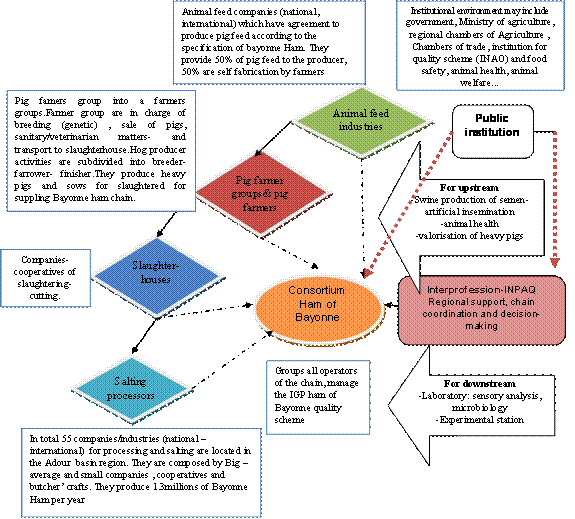Case 2 - Ham of Bayonne
Presentation of different components in Ham of Bayonne supply chain structure
The Ham of Bayonne chain is an example of a PGI chain (Protected Geographical Indication).
Indeed PGI Ham of Bayonne is the first PGI in France, obtained in 1998 by INPAQ, the Pork Inter-profession of Aquitaine Region.
http://www.jambon-de-bayonne.com/iso_album/jdb58_fetes_bye.pdf
http://ec.europa.eu/agriculture/quality/door/registeredName.html?denominationId=358&locale=en
PGI is a European official sign set-up in 1992 by the European Community. This quality sign concerns foodstuff products with characteristics that are strictly connected to a defined geographical zone, in which at least production or processing take place. The objective of this quality scheme is to protect the product and promote its specific characteristics. In France; the institution in charge of the PGI is INAO (National Institute for labels of Origins).
In the picture below the structure of the Ham of Bayonne chain is shown.

The chain of Ham of Bayonne is a complete chain composed by several operators from the pig production stage to processing. All operators are located in the limited geographical zone of PGI (Aquitaine region).
Upstream there is the South-west pig production with an output of about 3.5% of national production (about 700000 pigs per yea)r that serves as raw material for salting. Approximately 95% of the pig farmers are members of economic organizations like pig producer groups. Concerning feeding, about 50% of pig feed is produced on farms because the Aquitaine region is also an important producer of cereals and maize (30000 hectares of cereals).
The chain downstream is mainly composed of food industries located in the Adour Basin which process the Ham of Bayonne and produce per year 9,000 tons of ham or 1.3 million pieces. Processors are 80% large industries, 15% SMEs, and 5% butchers.
In 2006, there were in total about 1850 farmers, 33 pigs producer groups , 29 slaughterhouses and 5 units of cutting, 65 salting processors, and 2 salt producers in the Aquitaine region (SPL DIACT,Data 2006).
More specifically, the chain of Ham of Bayonne counts 438 farmers in the Adour basin region, 13 slaughterhouses and 35 salting structures with 40 small and craft companies.
Important actors in the chain of Ham of Bayonne are:
Consortium of Ham of Bayonne brings together several players of the chain: feed producers, pig producers and pig producer groups, slaughterhouses, and processors. The consortium operates as the branding organization of Ham of Bayonne accredited by the public authority INAO. The consortium manages the chain like promotion of the brand, specification and control as well as membership. In addition, the Consortium carries out bacteriological and physico-chemical analysis listed in the specifications of the PGI. The Consortium of Bayonne ham has also established a program to develop a database with physico-chemical, biochemical and sensory characteristics of Bayonne ham.
INPAQ (Aquitane Pork Inter-profession). The Interprofession INPAQ manages and coordinates a wide variety of institutions supporting the porkchain in Aquitaine region and Ham of Bayonne chain.
http://inpaq.org/public/inpaq.asp?id_V=271&id_A=2&id_p=&id_Rub=51
http://www.aquitainagri.org/PDF/PORCINS.PDF
http://www.franceclusters.fr/userfiles/annuaire_des_SPL.pdf
http://www.grandpau.com/pdf/diagnostic_4.pdf
http://www.dordogne.chambagri.fr/fileadmin/documents/Fiches_filieres/filPorc.pdf
Agriculture chambers. Institutions like the Agriculture chambers participate in chain activities (monitoring economic and technical activity and giving advice)
URGPPA is the Regional Association of pig producer groups of Aquitaine. It coordinates pig production
AREPSA (Animal health Association) coordinates disease control programs.
PYRAGENA is a centre for training and a research station for ham processing
http://www.jambon-de-bayonne.com/iso_album/ria_janvier2009.pdf
ABIOC is a quality control laboratory for animal health, food microbiology and sensory analysis, and molecular biology
Museum - House of Bayonne Ham is related to the Ham of Bayonne history, pig production in the Aquitaine region, and ham production
INPIG is a company for swine artificial insemination
VALTEC is a unit of valorisation of heavy pig, slaughtering, and cutting
ARPAQ -INPAQ Development : for collecting and managing financial funds, a guarantee fund investment
INPAQ Jobs is a group of employers to facilitate the recruitment and to train employees for salting
Other websites about quality signs:
http://www.civ-viande.org/uk/ebn.ebn?pid=108&rubrik=1&contenu=303
http://agriculture.gouv.fr/les-signes-europeens-aop-igp-stg
http://ec.europa.eu/agriculture/quality/
http://www.certipaq.com/index.php?option=com_content&task=view&id=49&Itemid=271